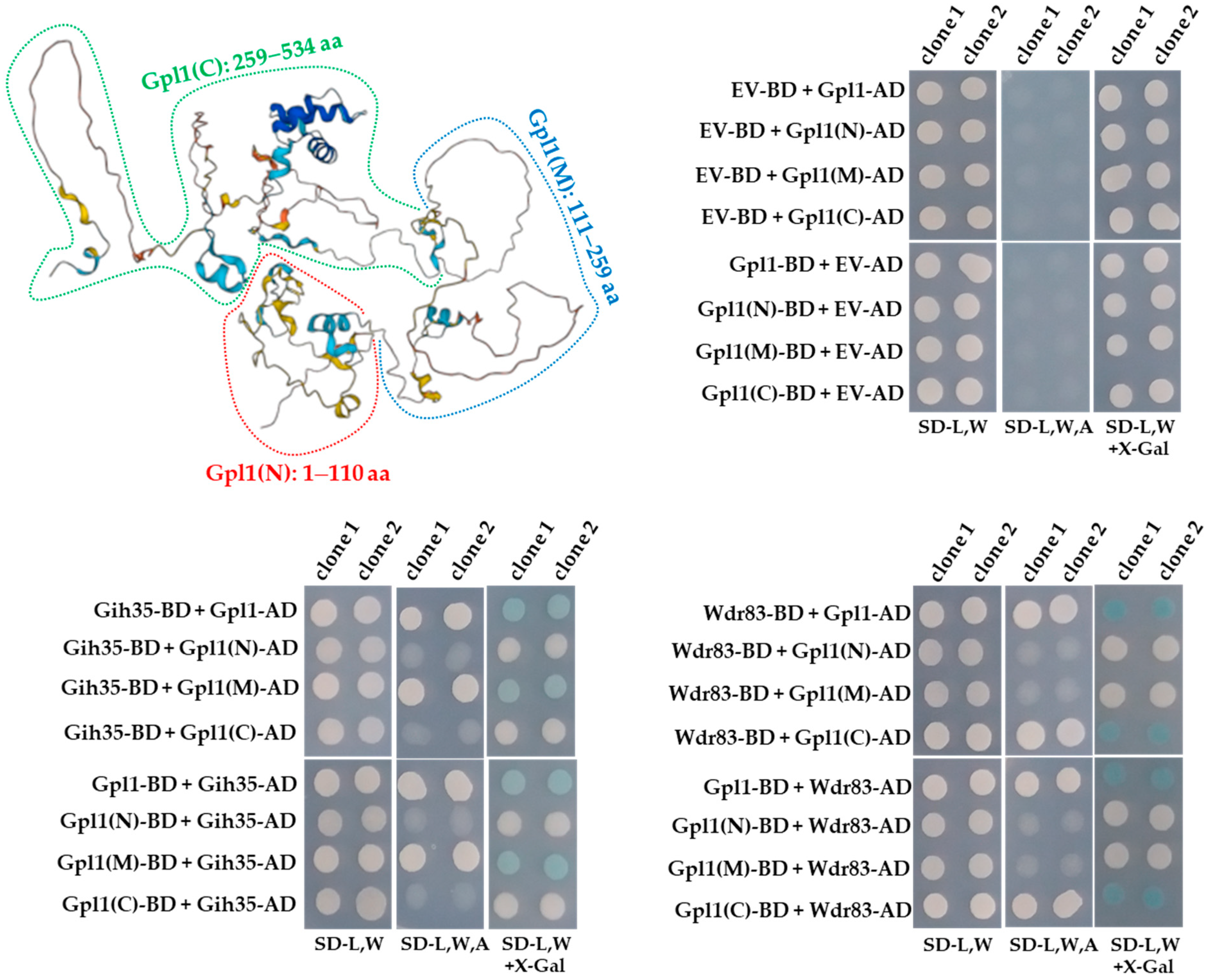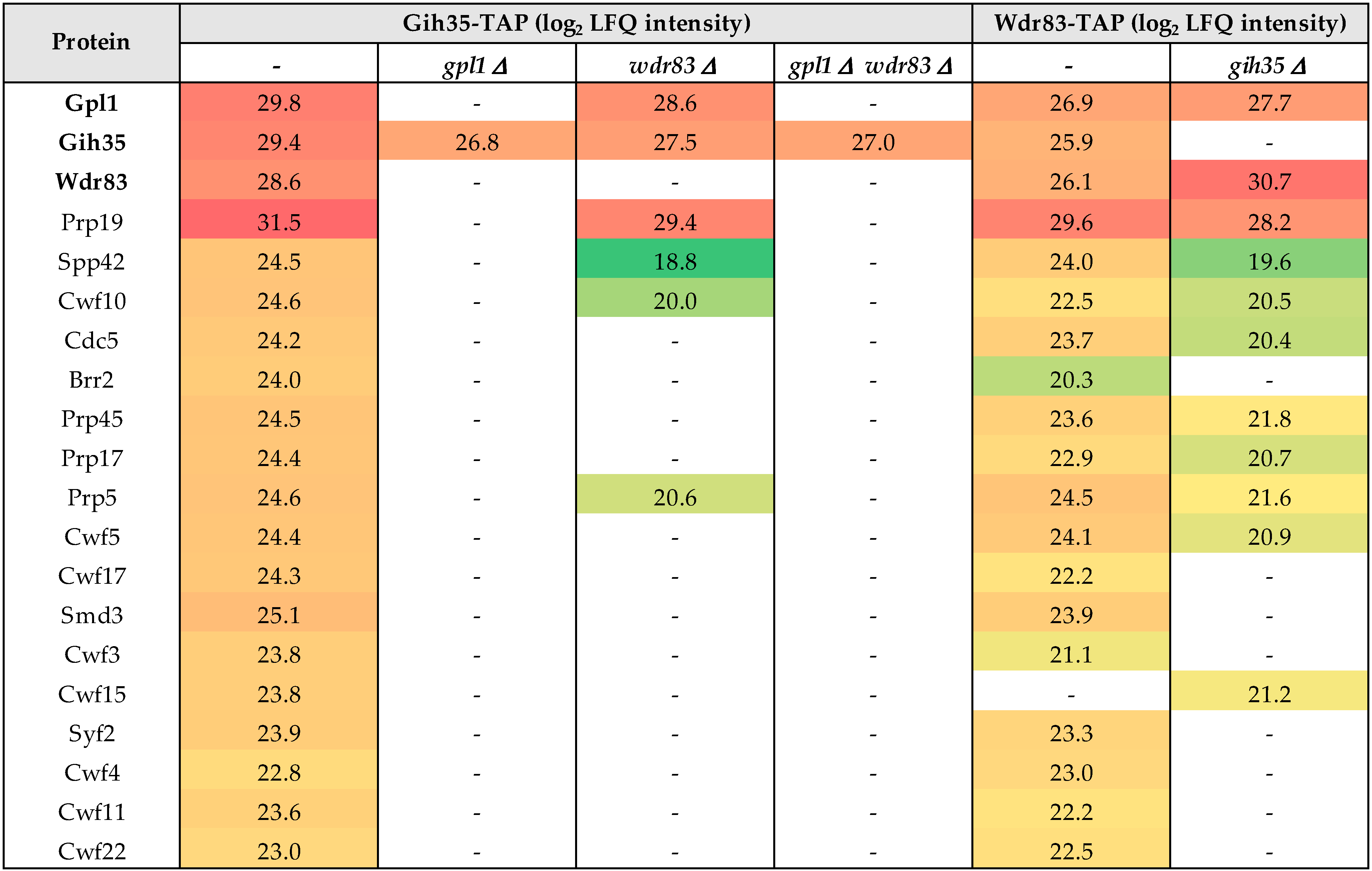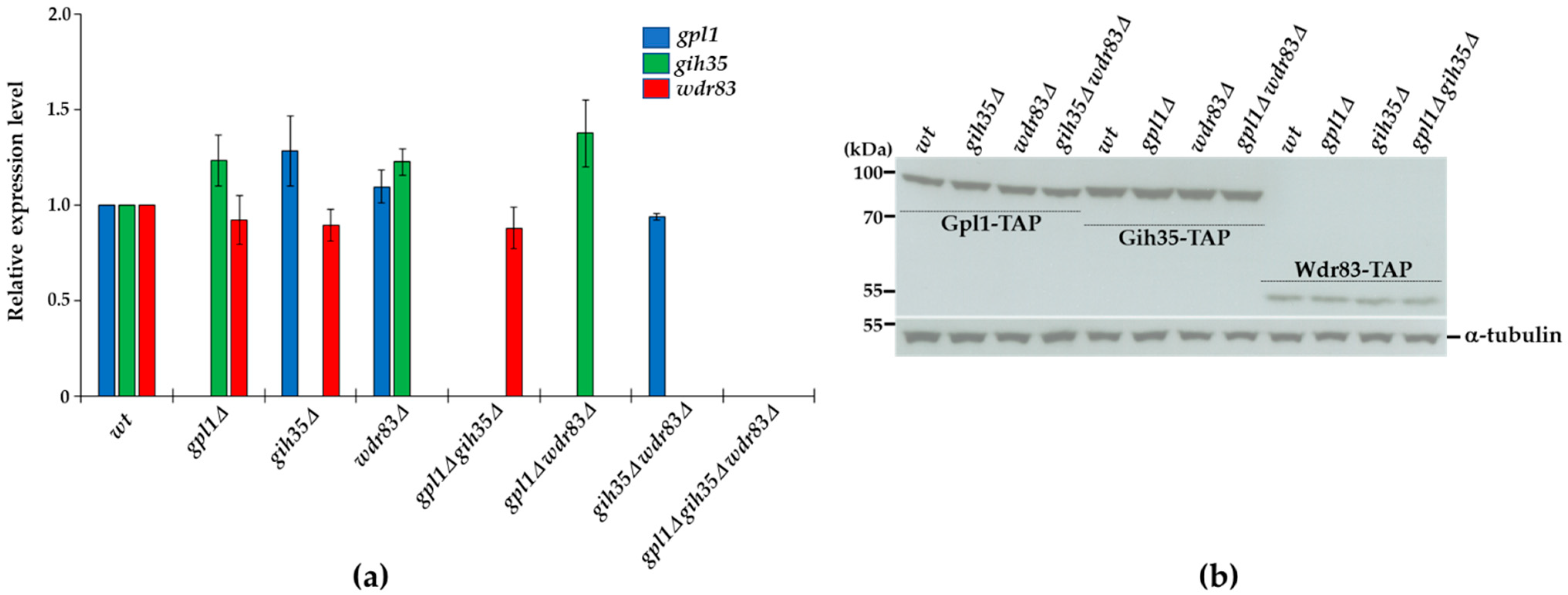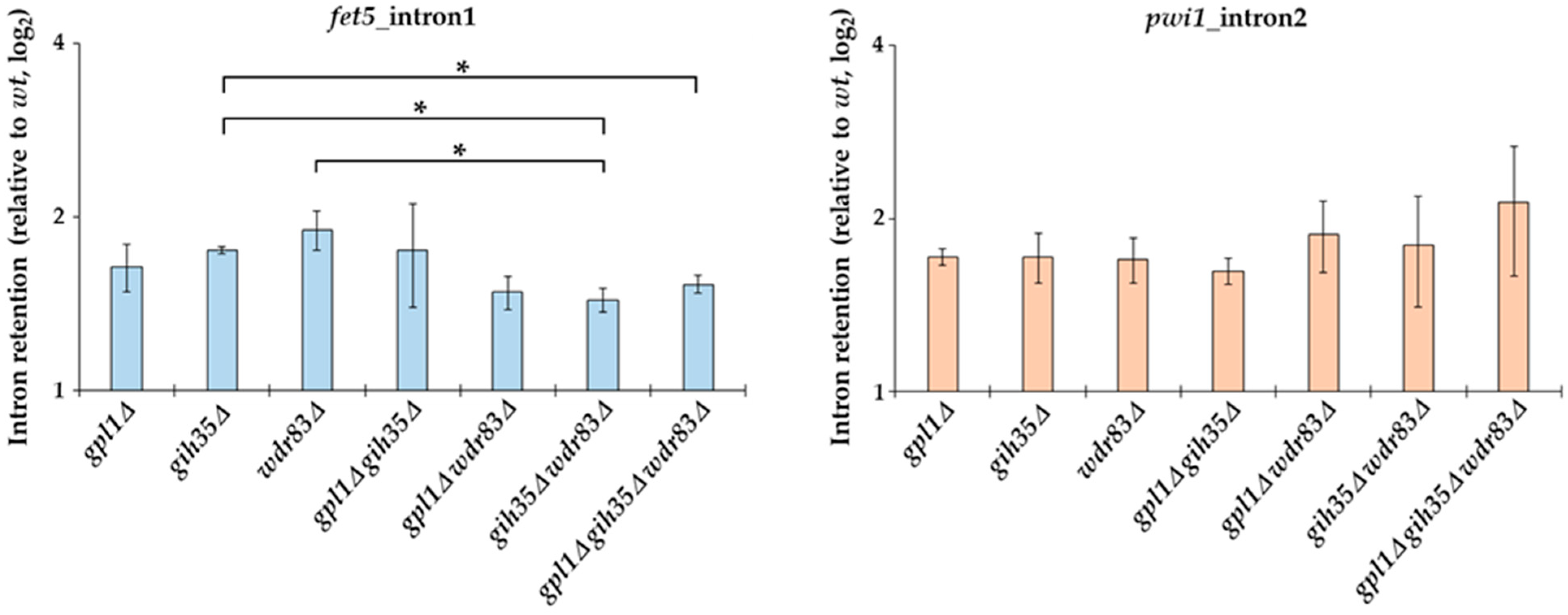Defining the Functional Interactome of Spliceosome-Associated G-Patch Protein Gpl1 in the Fission Yeast Schizosaccharomyces pombe
Abstract
1. Introduction
2. Results
2.1. Gpl1, Gih35 and Wdr83 Form a Complex That Associates with the Spliceosome
2.2. Gpl1 Mediates Interactions between Gih35 and Wdr83
2.3. Domain-Specific Interactions of Gpl1 with Gih35 and Wdr83
2.4. Gpl1 Is Important for Binding the Gpl1-Gih35-Wdr83 Complex to the Spliceosome
2.5. Expression of Proteins Forming the Gpl1-Gih35-Wdr83 Complex Is Mutually Independent
2.6. Deletions of the Gpl1-Gih35-Wdr83 Complex Components Affect the Splicing Efficiency
3. Discussion
4. Materials and Methods
4.1. Strains, Media and Growth Conditions
4.2. Tandem Affinity Purification
4.3. LC-MS/MS Analysis
4.4. Yeast-Two-Hybrid (Y2H) Assay
4.5. Analysis of Gene Expression and Splicing Efficacy by RT-qPCR
4.6. Western Blotting
4.7. Predicting Gpl1 Structure Using AlphaFold
Supplementary Materials
Author Contributions
Funding
Institutional Review Board Statement
Informed Consent Statement
Data Availability Statement
Conflicts of Interest
References
- Will, C.L.; Lührmann, R. Spliceosome structure and function. Cold Spring Harb. Perspect. Biol. 2011, 3, a003707. [Google Scholar] [CrossRef]
- Akerman, M.; Fregoso, O.I.; Das, S.; Ruse, C.; Jensen, M.A.; Pappin, D.J.; Zhang, M.Q.; Krainer, A.R. Differential connectivity of splicing activators and repressors to the human spliceosome. Genome Biol. 2015, 16, 119. [Google Scholar] [CrossRef]
- Gowravaram, M.; Bonneau, F.; Kanaan, J.; Maciej, V.D.; Fiorini, F.; Raj, S.; Croquette, V.; Le Hir, H.; Chakrabarti, S. A conserved structural element in the RNA helicase UPF1 regulates its catalytic activity in an isoform-specific manner. Nucleic Acids Res. 2018, 46, 2648–2659. [Google Scholar]
- Absmeier, E.; Santos, K.F.; Wahl, M.C. Molecular Mechanism Underlying Inhibition of Intrinsic ATPase Activity in a Ski2-like RNA Helicase. Structure 2020, 28, 236–243. [Google Scholar] [CrossRef] [PubMed]
- Luo, D.; Ding, S.C.; Vela, A.; Kohlway, A.; Lindenbach, B.D.; Pyle, A.M. Structural insights into RNA recognition by RIG-I. Cell 2011, 147, 409–422. [Google Scholar] [CrossRef]
- Kretschmer, J.; Rao, H.; Hackert, P.; Sloan, K.E.; Höbartner, C.; Bohnsack, M.T. The m6A reader protein YTHDC2 interacts with the small ribosomal subunit and the 5’-3’ exoribonuclease XRN1. RNA 2018, 24, 1339–1350. [Google Scholar] [CrossRef]
- Fuller-Pace, F.V.; Jacobs, A.M.; Nicol, S.M. Modulation of transcriptional activity of the DEAD-box family of RNA helicases, p68 (Ddx5) and DP103 (Ddx20), by SUMO modification. Biochem. Soc. Trans. 2007, 35, 1427–1429. [Google Scholar] [CrossRef]
- Mathew, R.; Hartmuth, K.; Möhlmann, S.; Urlaub, H.; Ficner, R.; Lührmann, R. Phosphorylation of human PRP28 by SRPK2 is required for integration of the U4/U6-U5 tri-snRNP into the spliceosome. Nat. Struct. Mol. Biol. 2008, 15, 435–443. [Google Scholar] [CrossRef]
- Das, T.; Park, J.K.; Park, J.; Kim, E.; Rape, M.; Kim, E.E.; Song, E.J. USP15 regulates dynamic protein-protein interactions of the spliceosome through deubiquitination of PRP31. Nucleic Acids Res. 2017, 45, 4866–4880. [Google Scholar] [PubMed]
- Bono, F.; Ebert, J.; Lorentzen, E.; Conti, E. The crystal structure of the exon junction complex reveals how it maintains a stable grip on mRNA. Cell 2006, 126, 713–725. [Google Scholar] [CrossRef]
- Erkizan, H.V.; Schneider, J.A.; Sajwan, K.; Graham, G.T.; Griffin, B.; Chasovskikh, S.; Youbi, S.E.; Kallarakal, A.; Chruszcz, M.; Padmanabhan, R.; et al. RNA helicase A activity is inhibited by oncogenic transcription factor EWS-FLI1. Nucleic Acids Res. 2015, 43, 1069–1080. [Google Scholar]
- Young, C.L.; Khoshnevis, S.; Karbstein, K. Cofactor-dependent specificity of a DEAD-box protein. Proc. Natl. Acad. Sci. USA 2013, 110, E2668–E2676. [Google Scholar] [CrossRef] [PubMed]
- Mugler, C.F.; Hondele, M.; Heinrich, S.; Sachdev, R.; Vallotton, P.; Koek, A.Y.; Chan, L.Y.; Weis, K. ATPase activity of the DEAD-box protein Dhh1 controls processing body formation. eLife 2016, 5, e18746. [Google Scholar] [PubMed]
- Davila Gallesio, J.; Hackert, P.; Bohnsack, K.E.; Bohnsack, M.T. Sgd1 is an MIF4G domain-containing cofactor of the RNA helicase Fal1 and associates with the 5’ domain of the 18S rRNA sequence. RNA Biol. 2020, 17, 539–553. [Google Scholar] [CrossRef] [PubMed]
- Aravind, L.; Koonin, E.V. G-patch: A new conserved domain in eukaryotic RNA-processing proteins and type D retroviral polyproteins. Trends Biochem. Sci. 1999, 24, 342–344. [Google Scholar] [CrossRef]
- Nourbakhsh, M.; Hauser, H. Constitutive silencing of IFN-beta promoter is mediated by NRF (NF-kappaB-repressing factor), a nuclear inhibitor of NF-kappaB. EMBO J. 1999, 18, 6415–6425. [Google Scholar] [CrossRef]
- Nourbakhsh, M.; Oumard, A.; Schwarzer, M.; Hauser, H. NRF, a nuclear inhibitor of NF-kappaB proteins silencing interferon-beta promoter. Eur. Cytokine Netw. 2000, 11, 500–501. [Google Scholar]
- Zang, S.; Lin, T.Y.; Chen, X.; Gencheva, M.; Newo, A.N.; Yang, L.; Rossi, D.; Hu, J.; Lin, S.B.; Huang, A.; et al. GPKOW is essential for pre-mRNA splicing in vitro and suppresses splicing defect caused by dominant-negative DHX16 mutation in vivo. Biosci. Rep. 2014, 34, e00163. [Google Scholar] [CrossRef] [PubMed]
- Banik, S.S.; Counter, C.M. Characterization of interactions between PinX1 and human telomerase subunits hTERT and hTR. J. Biol. Chem. 2004, 279, 51745–51748. [Google Scholar] [CrossRef] [PubMed]
- Bonnal, S.; Martínez, C.; Förch, P.; Bachi, A.; Wilm, M.; Valcárcel, J. RBM5/Luca-15/H37 regulates Fas alternative splice site pairing after exon definition. Mol. Cell 2008, 32, 81–95. [Google Scholar] [CrossRef] [PubMed]
- Lallena, M.J.; Chalmers, K.J.; Llamazares, S.; Lamond, A.I.; Valcárcel, J. Splicing regulation at the second catalytic step by Sex-lethal involves 3’ splice site recognition by SPF45. Cell 2002, 109, 285–296. [Google Scholar] [PubMed]
- Yoshimoto, R.; Kataoka, N.; Okawa, K.; Ohno, M. Isolation and characterization of post-splicing lariat-intron complexes. Nucleic Acids Res. 2009, 37, 891–902. [Google Scholar] [CrossRef] [PubMed]
- Chen, Z.; Gui, B.; Zhang, Y.; Xie, G.; Li, W.; Liu, S.; Xu, B.; Wu, C.; He, L.; Yang, J.; et al. Identification of a 35S U4/U6.U5 tri-small nuclear ribonucleoprotein (tri-snRNP) complex intermediate in spliceosome assembly. J. Biol. Chem. 2017, 292, 18113–18128. [Google Scholar] [CrossRef] [PubMed]
- Hegele, A.; Kamburov, A.; Grossmann, A.; Sourlis, C.; Wowro, S.; Weimann, M.; Will, C.L.; Pena, V.; Lührmann, R.; Stelzl, U. Dynamic protein-protein interaction wiring of the human spliceosome. Mol. Cell 2012, 45, 567–580. [Google Scholar] [CrossRef]
- Guglielmi, B.; Werner, M. The yeast homolog of human PinX1 is involved in rRNA and small nucleolar RNA maturation, not in telomere elongation inhibition. J. Biol. Chem. 2002, 277, 35712–35719. [Google Scholar] [CrossRef]
- Lin, J.; Blackburn, E.H. Nucleolar protein PinX1p regulates telomerase by sequestering its protein catalytic subunit in an inactive complex lacking telomerase RNA. Genes Dev. 2004, 18, 387–396. [Google Scholar] [CrossRef][Green Version]
- Christian, H.; Hofele, R.V.; Urlaub, H.; Ficner, R. Insights into the activation of the helicase Prp43 by biochemical studies and structural mass spectrometry. Nucleic Acids Res. 2014, 42, 1162–1179. [Google Scholar] [CrossRef]
- Lebaron, S.; Papin, C.; Capeyrou, R.; Chen, Y.L.; Froment, C.; Monsarrat, B.; Caizergues-Ferrer, M.; Grigoriev, M.; Henry, Y. The ATPase and helicase activities of Prp43p are stimulated by the G-patch protein Pfa1p during yeast ribosome biogenesis. EMBO J. 2009, 28, 3808–3819. [Google Scholar] [CrossRef]
- Banerjee, D.; McDaniel, P.M.; Rymond, B.C. Limited portability of G-patch domains in regulators of the Prp43 RNA helicase required for pre-mRNA splicing and ribosomal RNA maturation in Saccharomyces cerevisiae. Genetics 2015, 200, 135–147. [Google Scholar] [CrossRef]
- Heininger, A.U.; Hackert, P.; Andreou, A.Z.; Boon, K.L.; Memet, I.; Prior, M.; Clancy, A.; Schmidt, B.; Urlaub, H.; Schleiff, E.; et al. Protein cofactor competition regulates the action of a multifunctional RNA helicase in different pathways. RNA Biol. 2016, 13, 320–330. [Google Scholar] [CrossRef][Green Version]
- Boon, K.L.; Auchynnikava, T.; Edwalds-Gilbert, G.; Barrass, J.D.; Droop, A.P.; Dez, C.; Beggs, J.D. Yeast ntr1/spp382 mediates prp43 function in postspliceosomes. Mol. Cell. Biol. 2006, 26, 6016–6023. [Google Scholar] [CrossRef] [PubMed]
- Fourmann, J.B.; Dybkov, O.; Agafonov, D.E.; Tauchert, M.J.; Urlaub, H.; Ficner, R.; Fabrizio, P.; Lührmann, R. The target of the DEAH-box NTP triphosphatase Prp43 in Saccharomyces cerevisiae spliceosomes is the U2 snRNP-intron interaction. eLife 2016, 5, e15564. [Google Scholar] [CrossRef] [PubMed]
- Fourmann, J.B.; Tauchert, M.J.; Ficner, R.; Fabrizio, P.; Lührmann, R. Regulation of Prp43-mediated disassembly of spliceosomes by its cofactors Ntr1 and Ntr2. Nucleic Acids Res. 2017, 45, 4068–4080. [Google Scholar] [CrossRef] [PubMed]
- Tanaka, N.; Aronova, A.; Schwer, B. Ntr1 activates the Prp43 helicase to trigger release of lariat-intron from the spliceosome. Genes Dev. 2007, 21, 2312–2325. [Google Scholar] [CrossRef] [PubMed]
- Tsai, R.T.; Tseng, C.K.; Lee, P.J.; Chen, H.C.; Fu, R.H.; Chang, K.J.; Yeh, F.L.; Cheng, S.C. Dynamic interactions of Ntr1-Ntr2 with Prp43 and with U5 govern the recruitment of Prp43 to mediate spliceosome disassembly. Mol. Cell. Biol. 2007, 27, 8027–8037. [Google Scholar] [CrossRef]
- Silverman, E.J.; Maeda, A.; Wei, J.; Smith, P.; Beggs, J.D.; Lin, R.J. Interaction between a G-patch protein and a spliceosomal DEXD/H-box ATPase that is critical for splicing. Mol. Cell. Biol. 2004, 24, 10101–10110. [Google Scholar] [CrossRef] [PubMed]
- Warkocki, Z.; Schneider, C.; Mozaffari-Jovin, S.; Schmitzová, J.; Höbartner, C.; Fabrizio, P.; Lührmann, R. The G-patch protein Spp2 couples the spliceosome-stimulated ATPase activity of the DEAH-box protein Prp2 to catalytic activation of the spliceosome. Genes Dev. 2015, 29, 94–107. [Google Scholar] [CrossRef] [PubMed]
- Hamann, F.; Schmitt, A.; Favretto, F.; Hofele, R.; Neumann, P.; Xiang, S.; Urlaub, H.; Zweckstetter, M.; Ficner, R. Structural analysis of the intrinsically disordered splicing factor Spp2 and its binding to the DEAH-box ATPase Prp2. Proc. Natl. Acad. Sci. USA 2020, 117, 2948–2956. [Google Scholar] [CrossRef] [PubMed]
- Bai, R.; Wan, R.; Yan, C.; Jia, Q.; Lei, J.; Shi, Y. Mechanism of spliceosome remodeling by the ATPase/helicase Prp2 and its coactivator Spp2. Science 2021, 371, eabe8863. [Google Scholar] [CrossRef]
- Lock, A.; Rutherford, K.; Harris, M.A.; Wood, V. PomBase: The Scientific Resource for Fission Yeast. Methods Mol. Biol. 2018, 1757, 49–68. [Google Scholar]
- Aronica, L.; Kasparek, T.; Ruchman, D.; Marquez, Y.; Cipak, L.; Cipakova, I.; Anrather, D.; Mikolaskova, B.; Radtke, M.; Sarkar, S.; et al. The spliceosome-associated protein Nrl1 suppresses homologous recombination-dependent R-loop formation in fission yeast. Nucleic Acids Res. 2016, 44, 1703–1717. [Google Scholar] [CrossRef]
- Cipakova, I.; Jurcik, M.; Rubintova, V.; Borbova, M.; Mikolaskova, B.; Jurcik, J.; Bellova, J.; Barath, P.; Gregan, J.; Cipak, L. Identification of proteins associated with splicing factors Ntr1, Ntr2, Brr2 and Gpl1 in the fission yeast Schizosaccharomyces pombe. Cell Cycle 2019, 18, 1532–1536. [Google Scholar] [CrossRef]
- Mikolaskova, B.; Jurcik, M.; Cipakova, I.; Selicky, T.; Jurcik, J.; Polakova, S.B.; Stupenova, E.; Dudas, A.; Sivakova, B.; Bellova, J.; et al. Identification of Nrl1 Domains Responsible for Interactions with RNA-Processing Factors and Regulation of Nrl1 Function by Phosphorylation. Int. J. Mol. Sci. 2021, 22, 7011. [Google Scholar] [CrossRef] [PubMed]
- Larson, A.; Fair, B.J.; Pleiss, J.A. Interconnections between RNA-Processing Pathways Revealed by a Sequencing-Based Genetic Screen for Pre-mRNA Splicing Mutants in Fission Yeast. G3 2016, 6, 1513–1523. [Google Scholar] [CrossRef] [PubMed]
- Bourgeois, C.; Mortreux, F.; Auboeuf, D. The multiple functions of RNA helicases as drivers and regulators of gene expression. Nat. Rev. Mol. Cell Biol. 2016, 17, 426–438. [Google Scholar] [CrossRef] [PubMed]
- Sales-Lee, J.; Perry, D.S.; Bowser, B.A.; Diedrich, J.K.; Rao, B.; Beusch, I.; Yates, J.R., 3rd; Roy, S.W.; Madhani, H.D. Coupling of spliceosome complexity to intron diversity. Curr. Biol. 2021, 31, 4898–4910. [Google Scholar] [CrossRef] [PubMed]
- Ilagan, J.O.; Chalkley, R.J.; Burlingame, A.L.; Jurica, M.S. Rearrangements within human spliceosomes captured after exon ligation. RNA 2013, 19, 400–412. [Google Scholar] [CrossRef] [PubMed]
- Jumper, J.; Evans, R.; Pritzel, A.; Green, T.; Figurnov, M.; Ronneberger, O.; Tunyasuvunakool, K.; Bates, R.; Žídek, A.; Potapenko, A.; et al. Highly accurate protein structure prediction with AlphaFold. Nature 2021, 596, 583–589. [Google Scholar] [CrossRef]
- Varadi, M.; Anyango, S.; Deshpande, M.; Nair, S.; Natassia, C.; Yordanova, G.; Yuan, D.; Stroe, O.; Wood, G.; Laydon, A.; et al. AlphaFold Protein Structure Database: Massively expanding the structural coverage of protein-sequence space with high-accuracy models. Nucleic Acids Res. 2022, 50, D439–D444. [Google Scholar] [CrossRef]
- Bonnet, A.; Grosso, A.R.; Elkaoutari, A.; Coleno, E.; Presle, A.; Sridhara, S.C.; Janbon, G.; Géli, V.; de Almeida, S.F.; Palancade, B. Introns Protect Eukaryotic Genomes from Transcription-Associated Genetic Instability. Mol. Cell 2017, 67, 608–621.e6. [Google Scholar] [CrossRef]
- Chiu, A.C.; Suzuki, H.I.; Wu, X.; Mahat, D.B.; Kriz, A.J.; Sharp, P.A. Transcriptional Pause Sites Delineate Stable Nucleosome-Associated Premature Polyadenylation Suppressed by U1 snRNP. Mol. Cell 2018, 69, 648–663.e7. [Google Scholar] [CrossRef]
- Allemand, E.; Myers, M.P.; Garcia-Bernardo, J.; Harel-Bellan, A.; Krainer, A.R.; Muchardt, C. A Broad Set of Chromatin Factors Influences Splicing. PLoS Genet. 2016, 12, e1006318. [Google Scholar] [CrossRef] [PubMed]
- Jurica, M.S.; Moore, M.J. Pre-mRNA splicing: Awash in a sea of proteins. Mol. Cell 2003, 12, 5–14. [Google Scholar] [CrossRef]
- Wahl, M.C.; Will, C.L.; Lührmann, R. The spliceosome: Design principles of a dynamic RNP machine. Cell 2009, 136, 701–718. [Google Scholar] [CrossRef]
- Fabrizio, P.; Dannenberg, J.; Dube, P.; Kastner, B.; Stark, H.; Urlaub, H.; Lührmann, R. The evolutionarily conserved core design of the catalytic activation step of the yeast spliceosome. Mol. Cell 2009, 36, 593–608. [Google Scholar] [CrossRef] [PubMed]
- Chen, Y.L.; Capeyrou, R.; Humbert, O.; Mouffok, S.; Kadri, Y.A.; Lebaron, S.; Henras, A.K.; Henry, Y. The telomerase inhibitor Gno1p/PINX1 activates the helicase Prp43p during ribosome biogenesis. Nucleic Acids Res. 2014, 42, 7330–7345. [Google Scholar] [CrossRef]
- Memet, I.; Doebele, C.; Sloan, K.E.; Bohnsack, M.T. The G-patch protein NF-κB-repressing factor mediates the recruitment of the exonuclease XRN2 and activation of the RNA helicase DHX15 in human ribosome biogenesis. Nucleic Acids Res. 2017, 45, 5359–5374. [Google Scholar] [CrossRef]
- Robert-Paganin, J.; Halladjian, M.; Blaud, M.; Lebaron, S.; Delbos, L.; Chardon, F.; Capeyrou, R.; Humbert, O.; Henry, Y.; Henras, A.K.; et al. Functional link between DEAH/RHA helicase Prp43 activation and ATP base binding. Nucleic Acids Res. 2017, 45, 1539–1552. [Google Scholar] [CrossRef]
- Studer, M.K.; Ivanović, L.; Weber, M.E.; Marti, S.; Jonas, S. Structural basis for DEAH-helicase activation by G-patch proteins. Proc. Natl. Acad. Sci. USA 2020, 117, 7159–7170. [Google Scholar] [CrossRef] [PubMed]
- Dunn, A.Y.; Melville, M.W.; Frydman, J. Review: Cellular substrates of the eukaryotic chaperonin TRiC/CCT. J. Struct. Biol. 2001, 135, 176–184. [Google Scholar] [CrossRef] [PubMed]
- Miyata, Y.; Shibata, T.; Aoshima, M.; Tsubata, T.; Nishida, E. The molecular chaperone TRiC/CCT binds to the Trp-Asp 40 (WD40) repeat protein WDR68 and promotes its folding, protein kinase DYRK1A binding, and nuclear accumulation. J. Biol. Chem. 2014, 289, 33320–33332. [Google Scholar] [CrossRef] [PubMed]
- Gregan, J.; Rabitsch, P.K.; Rumpf, C.; Novatchkova, M.; Schleiffer, A.; Nasmyth, K. High-throughput knockout screen in fission yeast. Nat. Protoc. 2006, 1, 2457–2464. [Google Scholar] [CrossRef] [PubMed]
- Cipak, L.; Spirek, M.; Novatchkova, M.; Chen, Z.; Rumpf, C.; Lugmayr, W.; Mechtler, K.; Ammerer, G.; Csaszar, E.; Gregan, J. An improved strategy for tandem affinity purification-tagging of Schizosaccharomyces pombe genes. Proteomics 2009, 9, 4825–4828. [Google Scholar] [CrossRef]
- Cipak, L.; Selicky, T.; Jurcik, J.; Cipakova, I.; Osadska, M.; Lukacova, V.; Barath, P.; Gregan, J. Tandem affinity purification protocol for isolation of protein complexes from Schizosaccharomyces pombe. STAR Protoc. 2022, 3, 101137. [Google Scholar] [CrossRef] [PubMed]
- Rabilloud, T.; Carpentier, G.; Tarroux, P. Improvement and simplification of low-background silver staining of proteins by using sodium dithionite. Electrophoresis 1988, 9, 288–291. [Google Scholar] [CrossRef]
- Michalski, A.; Damoc, E.; Lange, O.; Denisov, E.; Nolting, D.; Müller, M.; Viner, R.; Schwartz, J.; Remes, P.; Belford, M.; et al. Ultra high resolution linear ion trap Orbitrap mass spectrometer (Orbitrap Elite) facilitates top down LC MS/MS and versatile peptide fragmentation modes. Mol. Cell. Proteom. 2012, 11, O111.013698. [Google Scholar] [CrossRef]
- Cox, J.; Mann, M. MaxQuant enables high peptide identification rates, individualized p.p.b.-range mass accuracies and proteome-wide protein quantification. Nat. Biotechnol. 2008, 26, 1367–1372. [Google Scholar] [CrossRef] [PubMed]
- Paoletti, A.C.; Parmely, T.J.; Tomomori-Sato, C.; Sato, S.; Zhu, D.; Conaway, R.C.; Conaway, J.W.; Florens, L.; Washburn, M.P. Quantitative proteomic analysis of distinct mammalian Mediator complexes using normalized spectral abundance factors. Proc. Natl. Acad. Sci. USA 2006, 103, 18928–18933. [Google Scholar] [CrossRef] [PubMed]
- Cox, J.; Hein, M.Y.; Luber, C.A.; Paron, I.; Nagaraj, N.; Mann, M. Accurate proteome-wide label-free quantification by delayed normalization and maximal peptide ratio extraction, termed MaxLFQ. Mol. Cell. Proteom. 2014, 13, 2513–2526. [Google Scholar] [CrossRef]
- Gietz, R.D. Yeast transformation by the LiAc/SS carrier DNA/PEG method. Methods Mol. Biol. 2014, 1205, 1–12. [Google Scholar]






Publisher’s Note: MDPI stays neutral with regard to jurisdictional claims in published maps and institutional affiliations. |
© 2022 by the authors. Licensee MDPI, Basel, Switzerland. This article is an open access article distributed under the terms and conditions of the Creative Commons Attribution (CC BY) license (https://creativecommons.org/licenses/by/4.0/).
Share and Cite
Selicky, T.; Jurcik, M.; Mikolaskova, B.; Pitelova, A.; Mayerova, N.; Kretova, M.; Osadska, M.; Jurcik, J.; Holic, R.; Kohutova, L.; et al. Defining the Functional Interactome of Spliceosome-Associated G-Patch Protein Gpl1 in the Fission Yeast Schizosaccharomyces pombe. Int. J. Mol. Sci. 2022, 23, 12800. https://doi.org/10.3390/ijms232112800
Selicky T, Jurcik M, Mikolaskova B, Pitelova A, Mayerova N, Kretova M, Osadska M, Jurcik J, Holic R, Kohutova L, et al. Defining the Functional Interactome of Spliceosome-Associated G-Patch Protein Gpl1 in the Fission Yeast Schizosaccharomyces pombe. International Journal of Molecular Sciences. 2022; 23(21):12800. https://doi.org/10.3390/ijms232112800
Chicago/Turabian StyleSelicky, Tomas, Matus Jurcik, Barbora Mikolaskova, Alexandra Pitelova, Nina Mayerova, Miroslava Kretova, Michaela Osadska, Jan Jurcik, Roman Holic, Lenka Kohutova, and et al. 2022. "Defining the Functional Interactome of Spliceosome-Associated G-Patch Protein Gpl1 in the Fission Yeast Schizosaccharomyces pombe" International Journal of Molecular Sciences 23, no. 21: 12800. https://doi.org/10.3390/ijms232112800
APA StyleSelicky, T., Jurcik, M., Mikolaskova, B., Pitelova, A., Mayerova, N., Kretova, M., Osadska, M., Jurcik, J., Holic, R., Kohutova, L., Bellova, J., Benko, Z., Gregan, J., Bagelova Polakova, S., Barath, P., Cipak, L., & Cipakova, I. (2022). Defining the Functional Interactome of Spliceosome-Associated G-Patch Protein Gpl1 in the Fission Yeast Schizosaccharomyces pombe. International Journal of Molecular Sciences, 23(21), 12800. https://doi.org/10.3390/ijms232112800





